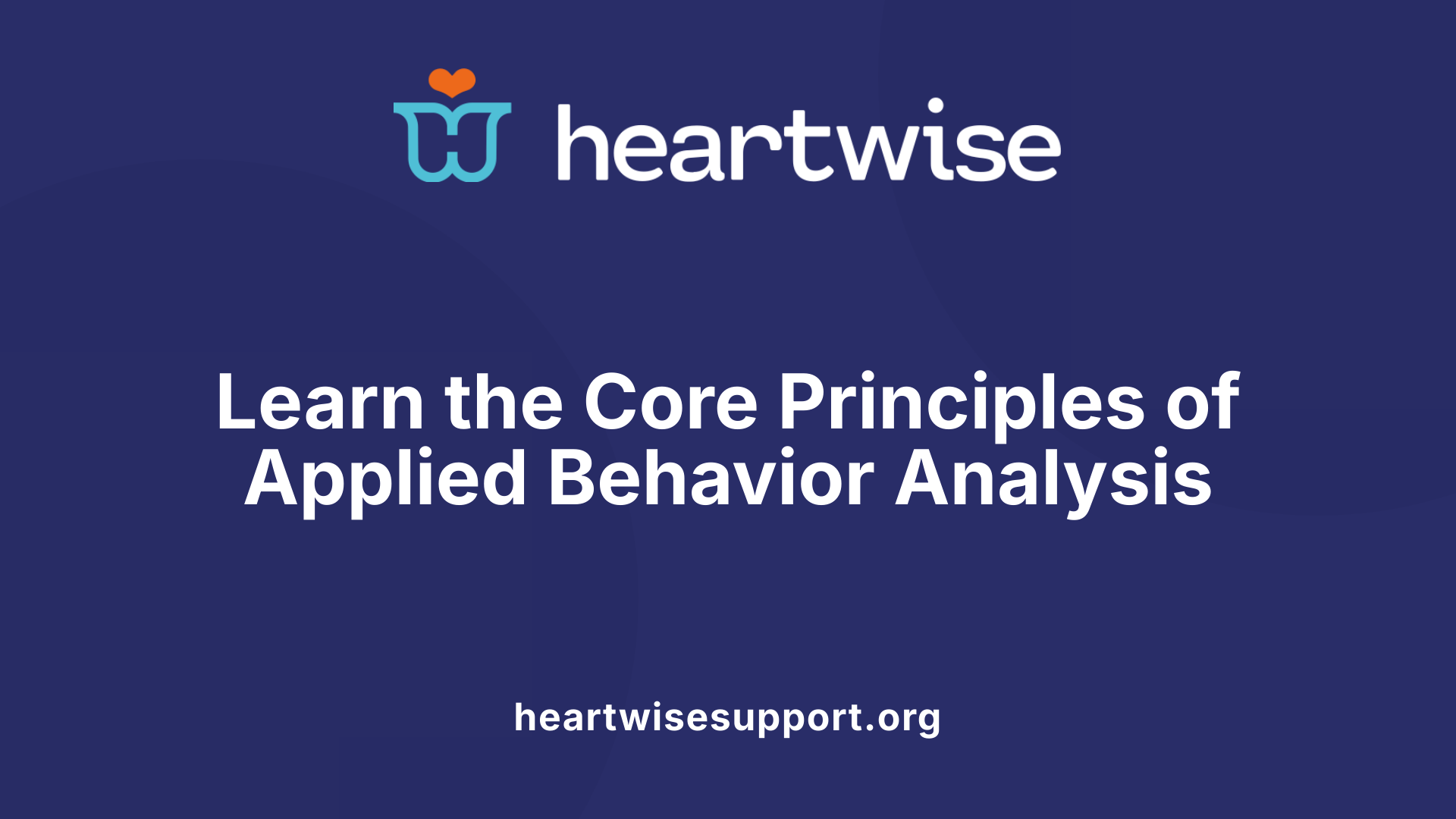Introduction to Applied Behavior Analysis (ABA) for Parents
Applied Behavior Analysis (ABA) is a scientifically grounded therapy widely recognized for its effectiveness in supporting children with autism and developmental challenges. This article aims to demystify ABA, explore its core principles, methods, and benefits, and guide parents on how to participate actively in their child's treatment journey. As an evidence-based practice, ABA emphasizes teaching useful skills, reducing harmful behaviors, and fostering independence, making it a cornerstone of modern behavioral interventions.
What Is ABA and Its Core Principles?

What is Applied Behavior Analysis (ABA) and what are its core principles?
Applied Behavior Analysis, commonly known as ABA, is a scientific discipline that focuses on understanding how behavior is learned and influenced by the environment. It is widely recognized as an effective, evidence-based approach to improve socially significant behaviors such as communication, social skills, self-care, and academic performance.
The foundational ideas behind ABA involve the use of reinforcement, which increases the likelihood of desired behaviors occurring again, and, in some cases, punishment to decrease harmful or unwanted behaviors. However, modern ABA emphasizes positive reinforcement methods, such as praise or rewards, over punitive measures.
ABA employs systematic, data-driven interventions that are tailored to each individual child’s needs. These interventions are grounded in learning theories and involve carefully structured techniques like prompting, fading, shaping, modeling, and task analysis.
Prompting involves giving cues to help a child perform a desired behavior, while fading gradually reduces these prompts to promote independence. Shaping means reinforcing successive approximations toward a target behavior, and modeling involves demonstrating behaviors for the child to imitate. Task analysis breaks complex skills into manageable steps for teaching.
An essential aspect of ABA is its adherence to the seven dimensions that ensure high-quality practice. These include effectiveness, meaning interventions actually produce meaningful change; generality, where skills transfer across different environments and situations; technological clarity, with clearly defined procedures; and other principles like applied, analytical, and capable of producing durable results.
Overall, ABA aims to bring about meaningful, lasting change by applying scientific principles across various settings, ensuring interventions are reliable, transferable, and tailored to individual needs.
How ABA Works and Its Role in Treating Autism and Developmental Disorders
 Applied Behavior Analysis (ABA) operates by systematically applying behavioral principles—such as reinforcement, prompting, shaping, and task analysis—to teach new skills and reduce problematic behaviors. These principles are based on the understanding that behavior is learned and influenced by environmental factors. Therapists identify specific target behaviors, break them down into smaller steps, and use positive reinforcement—like praise, toys, or access to preferred activities—to encourage desired behaviors. Moreover, prompts and fading techniques help children gradually acquire skills with consistent, data-driven adjustments.
Applied Behavior Analysis (ABA) operates by systematically applying behavioral principles—such as reinforcement, prompting, shaping, and task analysis—to teach new skills and reduce problematic behaviors. These principles are based on the understanding that behavior is learned and influenced by environmental factors. Therapists identify specific target behaviors, break them down into smaller steps, and use positive reinforcement—like praise, toys, or access to preferred activities—to encourage desired behaviors. Moreover, prompts and fading techniques help children gradually acquire skills with consistent, data-driven adjustments.
Each individual receiving ABA therapy undergoes a comprehensive assessment performed by a qualified professional, often a Board Certified Behavior Analyst (BCBA). This assessment helps determine the child's strengths, needs, preferences, and learning style. Based on this, a personalized treatment plan is developed, outlining specific goals in areas such as communication, social skills, self-care, and academic performance. These plans are flexible and evolve as the child progresses.
ABA employs various teaching methods tailored to learning preferences and developmental levels. Common approaches include Discrete Trial Training (DTT), which involves structured sessions with clear cues and rewards; Pivotal Response Treatment (PRT), focusing on motivation and self-initiations in more natural play settings; and the Early Start Denver Model (ESDM), which combines play-based activities with traditional ABA techniques to target multiple skills simultaneously.
In addition to direct interventions, ABA is often integrated with other therapies like speech therapy, occupational therapy, and psychological services. This multi-disciplinary approach ensures that developmental needs are addressed holistically, fostering better outcomes.
Technological advancements have also enhanced ABA interventions. Tools such as virtual reality, mobile applications, and artificial intelligence facilitate engaging, individualized therapy sessions and enable remote monitoring of progress. These innovations help maintain motivation and improve skill transfer across settings.
Family involvement is vital throughout the ABA process. Parents and caregivers are trained to implement strategies, reinforce skills at home, and ensure consistency across environments. This helps promote generalization of skills and sustains development over time.
Overall, ABA’s structured, evidence-based approach has demonstrated high effectiveness in improving communication, social interactions, daily living skills, and reducing harmful behaviors, especially when started early in a child's development.
Benefits, Effectiveness, and Criticisms of ABA Therapy
 Research shows that Applied Behavior Analysis (ABA) therapy is a well-supported, evidence-based approach for helping children with autism and behavioral challenges. It consistently leads to improvements across several areas, including communication, social skills, and daily living abilities. Early and intensive interventions—often lasting from 12 to 24 months—have demonstrated significant progress, particularly for children starting with lower baseline skills.
Research shows that Applied Behavior Analysis (ABA) therapy is a well-supported, evidence-based approach for helping children with autism and behavioral challenges. It consistently leads to improvements across several areas, including communication, social skills, and daily living abilities. Early and intensive interventions—often lasting from 12 to 24 months—have demonstrated significant progress, particularly for children starting with lower baseline skills.
ABA programs are highly individual, utilizing various methods like Discrete Trial Training, Pivotal Response Training, and Natural Environment Teaching. These approaches are tailored to meet each child's unique needs, helping them develop essential skills such as language, self-care, and emotional regulation. Many children benefit from this personalized focus, gaining meaningful skills that support independence and community participation.
Although some challenges exist—such as determining the appropriate intensity and duration of therapy—many children make considerable gains. For example, studies highlight improvements that can lead to reductions in the severity of autism symptoms and better integration into real-world settings.
However, ABA has faced criticism historically, mainly due to past practices that included aversive techniques like electric shocks. More recent developments emphasize ethical, person-centered approaches that avoid these methods. Critics also worry that traditional ABA may be overly rigid or focused on conformity, potentially suppressing behaviors that are meaningful to the individual.
In response, the field has shifted towards more naturalistic and respectful practices, such as Pivotal Response Training and other Naturalistic Developmental Behavioral Interventions, which capitalize on motivation, choice, and real-life contexts. These updates aim to prioritize the child's well-being, cultural identity, and personal preferences.
In summary, modern ABA is regarded as one of the most scientifically supported treatments for autism and behavioral challenges. When applied thoughtfully and ethically, it can provide substantial benefits that improve quality of life, skill development, and social participation, while ongoing research continues to enhance its practices and address past criticisms.
Techniques, Assessments, and Parental Support in ABA

What techniques, methods, and assessments are used in ABA therapy?
ABA therapy uses a range of proven techniques to shape and reinforce desired behaviors. One of the fundamental strategies is reinforcement, which can be positive — adding a pleasant stimulus to encourage a behavior — or negative — removing an unpleasant stimulus to increase that behavior. Prompting involves cues or hints to guide responses, which are then gradually faded to promote independence. Shaping is used to gradually teach new behaviors by reinforcing successive approximations towards the target skill.
Chaining techniques, such as task analysis, break down complex skills into smaller, manageable steps, teaching each part in sequence. Extinction involves reducing harmful or unwanted behaviors by withholding reinforcement. Modeling, including video modeling and picture-based systems like PECS (Picture Exchange Communication System), demonstrates desired behaviors for children to imitate.
Assessment is a crucial element of ABA, guiding individual treatment plans. Functional Behavior Assessments (FBA) analyze the antecedents and consequences of behaviors to understand their purpose. Skill evaluations like ABLLS-R (ape-based assessment focusing on language and social skills), VB-MAPP (Verbal Behavior Milestones Assessment and Placement Program), and Vineland-3 measure progress across various domains.
In addition to assessments, specific ABA methodologies include Discrete Trial Training (DTT), which involves repeated practice of skills in a structured setting, and Natural Environment Teaching (NET), which encourages learning through everyday activities and the child's interests. Visual supports, such as pictorial schedules and video modeling, enhance understanding and communication.
Data collection is integral to ABA, involving systematic recording of behaviors, which helps monitor progress and tailor strategies. This continuous evaluation ensures that interventions are effective and appropriately adjusted over time.
Overall, ABA combines evidence-based techniques with detailed assessments to support skill development and behavior change. Its comprehensive approach improves a child's ability to participate successfully across different environments, leading to meaningful progress.
Supporting Your Child at Home and Preparing for ABA Sessions

How can parents support and implement ABA strategies at home?
Parents play a vital role in reinforcing ABA techniques outside of therapy sessions. To support their child's learning, they should participate in parent training programs that teach them how to effectively use positive reinforcement, prompting, and shaping behaviors. These programs help parents understand how to reward desirable actions, such as sharing or saying words, and how to respond appropriately to challenging behaviors.
Creating a structured routine is essential. Visual aids like charts or picture schedules can help children anticipate daily activities, reducing anxiety and promoting independence. Using these tools ensures consistency and helps transfer skills learned in therapy to everyday situations.
Promoting generalization involves applying learned skills across various settings and keeping expectations clear and consistent. Reinforcing successes with praise, small rewards, or preferred activities encourages children to repeat positive behaviors.
Collaboration with therapists and the care team is crucial. Parents should regularly communicate with Behavior Analysts (BCBAs) and educators to tailor strategies that meet their child's current needs and monitor progress. Sharing observations from home enables adjustments to the intervention plan.
Engaging in ongoing support groups and seeking advice from professionals can boost parental confidence. Empowered parents are less stressed and better equipped to create a nurturing environment, fostering their child's growth and independence.
Summary and Final Recommendations
In conclusion, ABA remains a scientifically supported, versatile approach that can significantly support children’s growth across multiple domains. While it has faced criticisms, ongoing developments emphasize ethical and naturalistic methods respecting individual differences. Parents play a vital role in supporting therapy goals through collaboration, informed decision-making, and reinforcing skills at home. By partnering with qualified professionals and staying informed about the principles, techniques, and assessments involved, parents can help their children achieve meaningful improvements in behavior, communication, and independence, empowering them to participate more fully in everyday life.
References
- Applied Behavior Analysis (ABA) | Autism Speaks
- Helping Parents Understand Applied Behavior Analysis: Creating a ...
- Applied Behavior Analysis (ABA) - Cleveland Clinic
- Introduction to Applied Behavior Analysis (ABA): A Parent's Guide
- What is Applied Behavior Analysis (ABA): A Guide for Caregivers
- Understanding ABA: A Parent's Guide to Supporting Behavior
- The Controversy Around ABA - Child Mind Institute
- Applied Behavior Analysis (ABA): What Parents Need to Know -
- Applied Behaviour Analysis (ABA) and autistic children
- What to Expect in Your Child's ABA Assessment: A Parent's Guide











